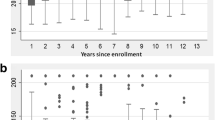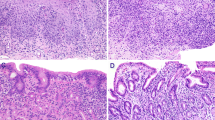Abstract
Background
Recent classification systems discriminate penetrating Crohn's disease (CD) from stricturing and non-stricturing/non-penetrating CD. As yet, no easily detectable marker is known that can predict the course of CD. Individual, clinical course-specific new treatment schemes would be highly desirable for different potentially divergent pathophysiological pathways (e.g., fistula vs stenosis).
Methods
Intestinal tissue biopsies from 63 CD patients with a disease follow-up of up to 7 years were studied retrospectively. In biopsy specimens, 34 histopathological features present prior to the onset of (a) strictures or (b) fistulas were evaluated and compared with biopsies from patients with non-stricturing/non-penetrating disease.
Results
Five histomorphological parameters demonstrated significant associations to different disease courses when applying univariate analysis. In a multivariate logistic regression model (1) severe lymphocytic infiltration of the lamina propria, (2) presence of crypt atrophy, and (3) absence of lymphocytic infiltration of the epithelium are the best variables to predict an uncomplicated disease course (Nagelkerke R2=0.329; P=0.001). The combination of these parameters has a sensitivity of 67% and a specificity of 83% to predict non-stricturing/non-penetrating disease (positive predictive value=0.75).
Conclusion
Histopathological parameters may help to predict complications of CD prior to their onset. The results of this study have to be confirmed prospectively.

Similar content being viewed by others
References
Borley NR, Mortensen NJ, Kettlewell M, George B, Jewell D, Warren B (2001) Connective tissue changes in ileal Crohn's disease: relationship to disease phenotype and ulcer-associated cell lineage. Dis Colon Rectum 44:388–396
Gasche C, Scholmerich J, Brynskov J, D'Haens G, Hanauer SB, Irvine EJ, Jewell DP, Rachmilewitz D, Sachar DB, Sandborn WJ, Sutherland LR (2000) A simple classification of Crohn's Disease: report of the Working Party for the World Congresses of Gastroenterology, Vienna 1998. Inflamm Bowel Dis 6:8–15
Gelbmann CM (2000) Prediction of treatment refractoriness in ulcerative colitis and Crohn's disease—do we have reliable markers? Inflamm Bowel Dis 6:123–131
Graham MF, Diegelmann RF, Elson CO, Lindblad WJ, Gotschalk N, Gay S, Gay R (1998) Collagen content and types in the intestinal strictures of Crohn's disease. Gastroenterology 94:257–265
Hilsden RJ, Meddings JB, Hardin J, Gall DG, Sutherland LR (1999) Intestinal permeability and postheparin plasma diamine oxidase activity in the prediction of Crohn's disease relapse. Inflamm Bowel Dis 5:85–91
Hirata I, Berrebi G, Austin LL, Keren DF, Dobbins WO (1986) Immunohistological characterization of intraepithelial and lamina propria lymphocytes in control ileum and colon and inflammatory bowel disease. Dig Dis Sci 31:593–603
Le Berre NL, Heresbach D, Kerbaol M, Caulet S, Bretagne JF, Chaperon J, Gosselin M, Ramée MP (1995) Histological discrimination of idiopathic inflammatory bowel disease from other types of colitis. J Clin Pathol 48:749–753
Lennard Jones JE (1989) Classification of inflammatory bowel disease. Scand J Gastroenterol 170[Suppl]:2–6
Lesage S, Zouali H, Cezard JP, Colombel JF, Belaiche J, Almer S, Tysk C, O'Morain C, Gassull M, Binder V, Finkel Y, Modigliani R, Gower-Rousseau C, Macry J, Merlin F, Chamaillard M, Jannot AS, Thomas G, Hugot JP (2002) CARD15/NOD2 mutational analysis and genotype-phenotype correlation in 612 patients with inflammatory bowel disease. Am J Hum Genet 70:845–857
McAlindon ME, Gray T, Galvin A, Sewell HF, Podolsky DK, Mahida YR (1998) Differential lamina propria cell migration via basement membrane pores of inflammatory bowel disease mucosa. Gastroenterology 115:841–848
Modigliani R and the GETAID group (1990) Clinical, biological and endoscopic picture of attacks of Crohn's disease. Gastroenterology 98:811–818
Riddell RH, Goldman H, Ransohoff DF, Appelman HD, Fenaglio CM, Haggitt RC, Ahren C, Correa P, Hamilton SR, Morson BC (1983) Dysplasia in inflammatory bowel disease: standardized classification with provisional clinical applications. Hum Pathol 14:931–968
Roseth AG, Aadland E, Jahnsen J, Raknerud N (1997) Assessment of disease activity in ulcerative colitis by faecal calprotectin, a novel granulocyte marker protein. Digestion 58:176–180
Roseth AG, Fagerhol MK, Aadland E, Schonsby H (1992) Assessment of the neutrophil dominating protein calprotectin in feces. A methodologic study. Scand J Gastroenterol 27:793–798
Schreiber S, Nikolaus S, Hampe J, Hamling J, Koop I, Groessner B, Lochs H, Raedler A (1999) Tumor necrosis factor alpha and interleukin 1 beta in relapse of Crohn's disease. Lancet 353:459–461
Seldenrijk CA, Morson BC, Meuwissen SG, Schipper NW, Lindeman J, Meijer CJ (1991) Histopathological evaluation of colonic mucosal biopsy specimens in chronic inflammatory bowel disease: diagnostic implications. Gut 32:1514–1520
Senju M, Wu KC, Mahida YR, Jewell DP (1990) Two color immunofluorescence and flow cytometric analysis of lamina propria lymphocyte subsets in ulcerative colitis and Crohn's disease. Dig Dis Sci 36:1453–1458
Surawicz CM, Belic L (1984) Rectal biopsy helps to distinguish acute self-limited colitis from idiopathic inflammatory bowel disease. Gastroenterology 86:104–113
Tanaka M, Riddell RH, Saito H, Soma Y, Hidaka H, Kudo H (1999) Morphologic criteria applicable to biopsy specimens for effective distinction of inflammatory bowel disease from other forms of colitis and of Crohn's disease from ulcerative colitis. Scand J Gastroenterol 34:55–67
Teahon K, Smethurst P, Levi A, Menzies IS, Bjarnason I (1992) Intestinal permeability in patients with Crohn's disease and their first degree relatives. Gut 33:320–323
Tibble JA, Sigthorsson G, Bridger S, Fagerhol MK, Bjarnason I (2000) Surrogate markers of intestinal inflammation are predictive of relapse in patients with inflammatory bowel disease. Gastroenterology 119:15–22
Wyatt J, Vogelsang H, Hubl W, Waldhoer T, Lochs H (1993) Intestinal permeability and the prediction of relapse in Crohn's disease. Lancet 341:1437–1439
Acknowledgement
This work was supported by the Bundesministerium für Bildung und Forschung (BMBF) Competence network "Inflammatory Bowel Disease".
Author information
Authors and Affiliations
Corresponding author
Rights and permissions
About this article
Cite this article
Bataille, F., Klebl, F., Rümmele, P. et al. Histopathological parameters as predictors for the course of Crohn's disease. Virchows Arch 443, 501–507 (2003). https://doi.org/10.1007/s00428-003-0863-6
Received:
Accepted:
Published:
Issue Date:
DOI: https://doi.org/10.1007/s00428-003-0863-6




